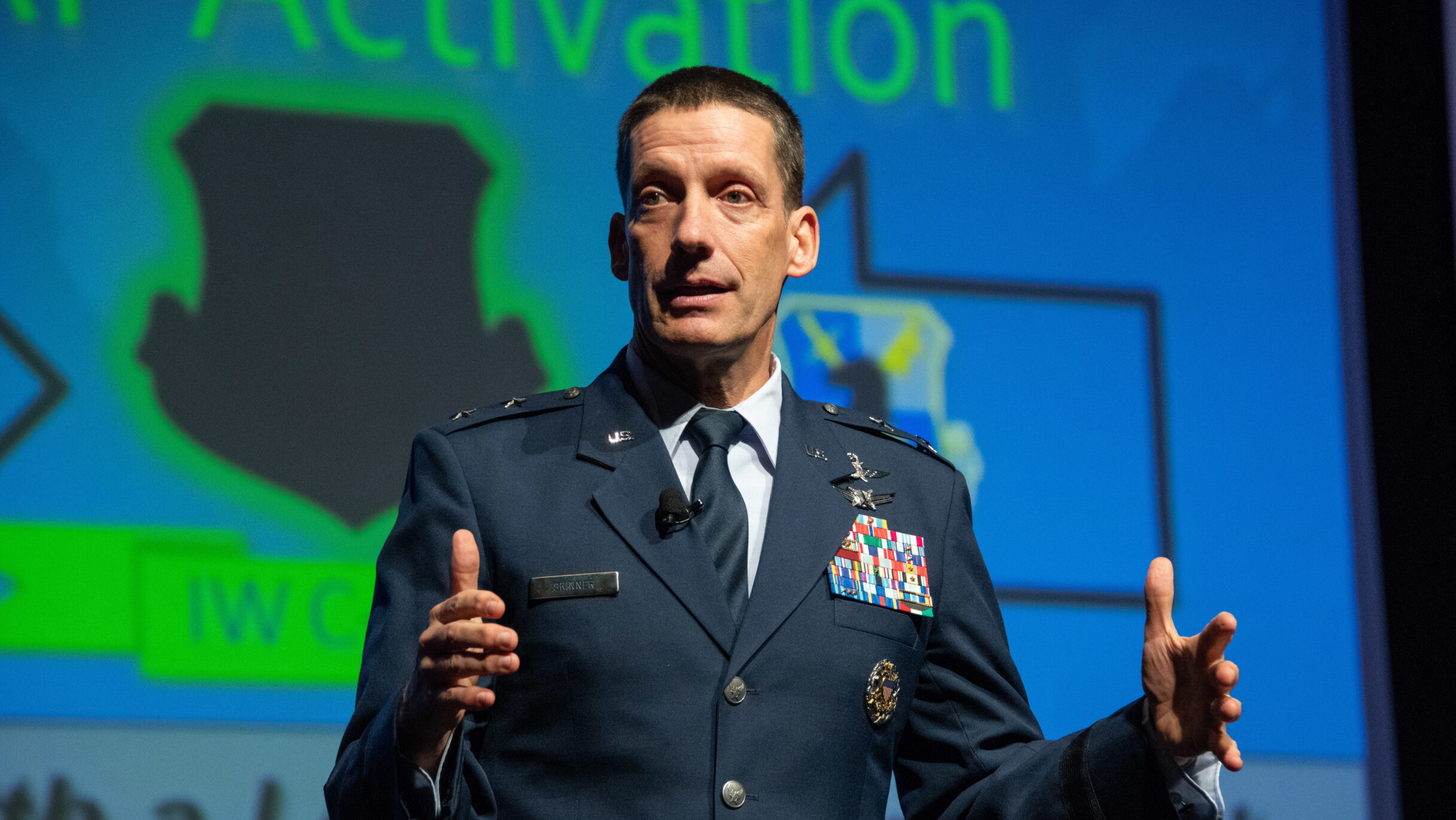
Major General Robert J. Skinner, Commander, 24th Air Force; Commander, Air Forces Cyber, and Commander, Joint Force Headquarters-Cyber, addresses attendees of the Air Force Information Technology & Cyberpower Conference August 26, 2019. (US Air Force photo by Cassandra Cornwell/Released
WASHINGTON: Facing the monumental task that is modernizing the Pentagon’s networks, the head of the Defense Information Systems Agency recently told Breaking Defense his agency is “re-imagining” how it does things, including shepherding through two major contract initiatives that are meant to work hand-in-hand to provide secure services across the sprawling military org chart.
In January, DISA awarded Booz Allen Hamilton a $6.8 million prototype contract for Thunderdome, its zero-trust security and network architecture program. At the time DISA said it wanted to move away from the “siloed nature of the classic defense-in-depth security model” and toward “integrating security from the end user all the way to the data being accessed.”
Then, earlier this month, Leidos nabbed the massive $11.5 billion Defense Enclave Services (DES) contract, an effort to streamline the Pentagon’s vast network infrastructure of non-service-specific agencies. Under the indefinite-delivery, indefinite-quantity contract, the company will be responsible for leading the Fourth Estate Network Optimization initiative, a process that will consolidate systems, personnel and functions, among other program elements.
For DISA chief Lt. Gen. Robert Skinner, the two initiatives are key to his agency’s future work.
“Thunderdome is a way to reimagine… how we look at networks in the future and it’s really more data-centric than it is the old equipment and hardware-focused,” Skinner told Breaking Defense in an exclusive interview last week. “But hardware is still a big part of it because one of the things that we’re really trying to do as a department is not necessarily move away, but really try to transition, from being a kind of hardware company and organization to becoming a software company and organization which really provides a lot more flexibility as we look at providing the services we provide.”
DISA announced over the next six months it planned to produce a working prototype of Thunderdome that’s scalable across DoD. There will be “four or five services” provided under Thunderdome, including Secure Access Service Edge, or SASE, which Skinner described as “a modern way of doing our virtual private networking” where people can access the network from any place, application security stacks and cloud defensive cyber operations.
He added there’s potential for the pilot, if it meets all requirements, to become the minimal viable product that can actually be rolled across DoD. DISA has established cross-functional teams across the agency for the effort and is working with other services — currently the Air Force — to identify their needs.
RELATED: milCloud 2.0 To Die A Quiet Death In Spring 2022
DISA is also purchasing equipment for the effort, which could be delayed due to supply chain issues, but the goal within the next couple of months remains the same – to have equipment in hand at different locations, Skinner said.
Those locations are still being finalized, but DISA Pacific Field Command in Hawaii likely will be prioritized “because our other focus has to continue to be on the Pacific and making sure that we are taking care of the strategic priority of the department which continues to be the Indo-Pacific and what’s happening out there in relation to China.”
Then comes the melding of Thunderdome with the DES, which would extend the zero-trust concept further across the Pentagon to “fourth estate” agencies.
The Thunderdome contract “plays hand-in-hand” with the DES contract, Skinner said, “because as we’re re-imagining how we provide the services and manage, there’s a technical component that plays in with the personnel and contract components. So they all kind of play together.”
At the same time, broadly speaking Skinner said he envisions DES as a way to consolidate contracting for network-related capabilities, reducing the amount of contract actions and activities that need to occur.
RELATED: DES: Defense Enclave Services Will Be DISA’s ‘Crown Jewel’
“So what we’re trying to do with the DES contract is through one contractor bringing all the innovation and the good things that we provide from network performance, network monitoring and network management,” he said. “That’s really what DES is supposed to be. We’re trying to integrate, be consistent and accountable for the consolidation of all these IT integrated network operations — that’s the end goal.”
Through DES, DISA will focus on how to best provide support to agencies and organizations that are transitioning “from kind of the current systems that they’re on” to the Department of Defense Network, or DODNET, bringing them all onto one Fourth Estate network that provides everyone the same level of security and resiliency, Skinner added.
However, work on the DES contract has been slowed down due to a protest filed by General Dynamics Information Technology on March 10. The GAO is expected to make a decision no later than June 20.
Skinner said “based from a contractual standpoint, there have been discussions, but with the protest that kind of put everything on hold as we kind of work through the protest action activities and working with GAO and others.”
GDIT declined to comment for this report.
Skinner said DISA is moving in a good direction as it leverages technology and its “three ring approach” to supporting DoD, the warfighter, decision makers and analysts.
“I think everybody should be confident in our capabilities and the things that we’re doing for the nation and taxpayer,” he said.
L3Harris selloffs hampered by low bids, CEO says
“To the extent we can get a good price for what we’ve identified as non-core [businesses], we’ll do it. But too many of the offers are coming in low and people think we’re desperate to sell, and I can assure you we’re not,” said L3Harris CEO Chris Kubasik.


























